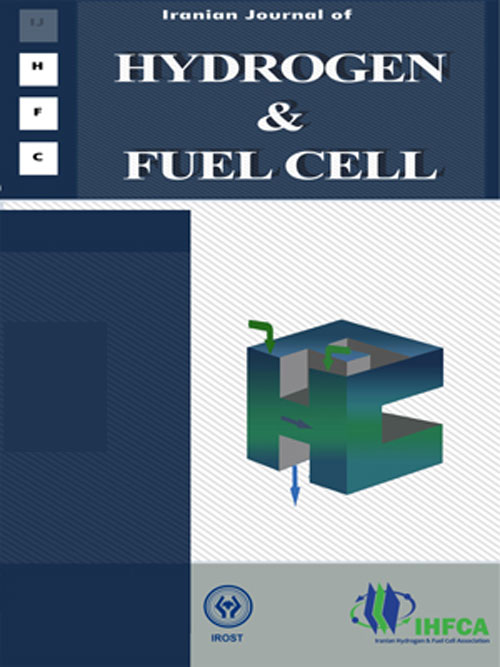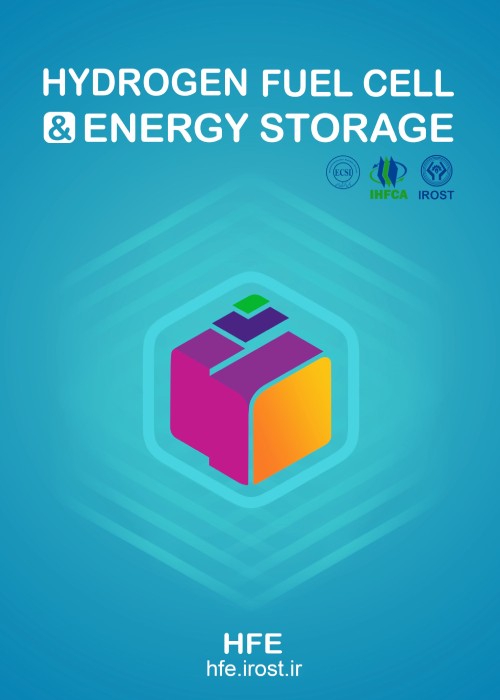فهرست مطالب

Journal of Hydrogen, Fuel Cell and Energy Storage
Volume:1 Issue: 3, Summer 2014
- تاریخ انتشار: 1393/07/19
- تعداد عناوین: 6
-
-
Pages 133-139In this work, electrocatalyst with core-shell structure (Pd as core and Pt as shell on VulcanXC-72R) was synthesis. Not only this structure can reduce the amount of platinum but it also can increase the gas diffusion electrode (GDE) performance in cathode reaction (Oxygen Reduction Reaction or ORR) of polymer electrolyte membrane fuel cell (PEMFC). To this meaning, one series of electrocatalyst with different molar ratio of metals (Pd @ Pt), was prepared and applied in electrode fabrication. The used synthesis method was impregnation with hydrothermal. The performance of the electrodes in ORR was studied by linear sweep voltametery (LSV), electrochemical impedance spectroscopy (EIS), chronoamperometery techniques and the MEA were also tested. Inductive coupled plasma (ICP), X-ray diffraction (XRD), transmission electron microscopy (TEM) techniques was used to characterize the electrocatalyst. The results indicated that the electrocatalyst with 3:1 molar ratio for Pd: Pt enhanced the cathode in MEA performance. This result can be attributed to the positive effect of Pd, particle size and catalyst distribution on substrate that consequently, provide the best three phase zone.Keywords: core, shell structure, polymer electrolyte fuel cell, Oxygen Reduction Reaction, Pt, Pd
-
Pages 141-152Computational fluid dynamics analysis was employed to investigate the radial flow field patterns of proton exchange membrane fuel cells (PEMFC) with different channel geometries at high operating current densities. 3D, non-isothermal was used with single straight channel geometry. Our study showed that new generation of fuel cells with circle stack with the same active area and inlet area gave higher current density compared with conventional model. the main factors that affect the behavior of each of the curves are discussed. Species and temperature contours are presented for the new model, showing how the fuel cell behavior is affected by species penetration due to increasing inlet and outlet in one mono cell (four inlet and out let) with inclined in the radial channel configuration.Velocity trends are presented for the two different models, showing how the fuel cell behavior is affected by the velocity variations in the radial configuration. Thus, the results presented here suggest that the radial geometry is a strong candidate for the near-future development of the fuel cell technology.Keywords: Fuel cell performance, PEM fuel cells, Single, phase, Radial channel flow
-
Pages 153-161Hydrogen was produced by steam reforming of dimethyl ether (DME) using a physical mixture of commercial HZSM-5 zeolite (for DME hydrolyzing) and Cu/ZnO/Al2O3 (for methanol steam reforming) as a catalyst in a fixed bed reactor. The experiments were performed at atmospheric pressure and in a temperature range from 270 to 310 °C. The effects of feed temperature and gas hourly space velocity (GHSV) between 2420 and 4615 h−1 on DME conversion and H2 and CO concentrations in the gas-phase products were investigated. In addition, the temperature changes along the catalyst bed were measured. The results showed that DME conversion increased with increasing temperature, and also, DME conversion decreased with increasing GHSV. Finally, a homogeneous one-dimensional model was used to model the reactor of hydrogen production by steam reforming of DME. The predicted temperature profile along the catalyst bed and conversion were compared with the experimental data. The model results and experimental data were found to be in good agreement.Keywords: Dimethyl Ether, Hydrogen production, Steam Reforming, Modeling, Fixed Bed Reactors
-
Pages 163-173A hydrothermal method for preparation of nano-size zirconia has been studied to optimize the effective parameters (precursor concentration, temperature and time) using response surface methodology (RSM). The synthesized zirconia samples were characterized through X-ray diffraction (XRD), scanning electron microscope (SEM) and transmission electron microscopy (TEM) analyses to identify mean nanoparticles size of the zirconia powders and molar fraction of monoclinic and tetragonal (or cubic) crystalline phases. Since, tetragonal and cubic phases are more valuable for the technological applications than the monoclinic phase, improving synthesis of tetragonal and cubic crystalline phases has been considered. The analysis of the primary experimental data through RSM method for optimization of the parameters showed that a precursor concentration of about 0.0092 mol L–1, a reaction temperature of 150 °C and a reaction time of 83.18 h are the optimum process conditions which give a mean zirconia nanoparticles size of ~23 nm and a high molar fraction of tetragonal (or cubic) crystalline phases (~70%) simultaneously.Keywords: Nano, size zirconia, Commercial zirconia, Hydrothermal synthesis, Response surface methodology
-
Pages 175-188In this article, one-phase and three dimensional computational fluid dynamics analysis was utilized to investigate the effect of annular field pattern of proton exchange membrane fuel cells (PEMFC) with different geometry on the performances and species distribution. This computational fluid dynamics code is used for solving the equation in single domain namely the flow field, the mass conservation, the energy conservation, the species transport, and the electric/ionic fields under the assumptions of steady state and non-isothermal. The introduced cell consist of different novelties, such as the way in which reactant gases are supplied to the flow field, the design of the flow field geometry for both anode and cathode and the membrane electrode assembly design and the length and occupied volume decreases up to 40%. Obtained results showed that generation of fuel cells with annular shaped geometry with the same active area and inlet area gave intensively higher current density compared with conventional model. Oxygen, hydrogen and water mass fraction distributions, current density and temperature distribution has been studied. The main factors that affect the behavior of each of the curves are discussed comprehensively. Intorduced configuration allows for better flow distribution and uses of the maximum active area and diffusion from two side in each channels. Furthermore, the effect of changing the GDL thickness is presented in order to understand the effect of different parameters. Simulation results were compared with the experimental data and confirm the accuracy of model.Keywords: cell performance, PEM fuel cells, Single, phase, Annular geometry
-
Pages 189-197Nanocrystalline ceria has been considered as support for carbon monoxide preferentially oxidation. In this study ceria was prepared by precipitation method and the effects of preparation conditions, such as pH of solution (8-10), aging time (1-12 hr), drying temperature (80-120 °C), calcination time (2-6 hr) and temperature (400-600 °C) were investigated on ceria synthesized powders properties. Nanocrystalline ceria were characterized by thermal gravimetric analysis (TGA), X-ray diffraction (XRD) and ASAP analysis. Calcination temperature and pH of solution have the highest effect on powder specific area. Finally, optimum conditions for the synthesis of cerium oxide in this study are pH = 10, aging time = 6 hr, drying temperature = 120 °C, calcination time = 6 hr, and temperature = 500 °C. Crystalline size of ceria is lower than 20 nm and in the shape of sphere-like and maximum surface area is 74.45 m2/g. 7%CuO/CeO2 catalyst was prepared by wetness impregnation method and was tested in catatest for oxidation of CO in presence of hydrogen (preferentially oxidation, PrOx). The CO conversion and CO2 selectivity was achieved 57.3 – 98% and 83-40% by temperature increasing from 80-180 °C, respectively.Keywords: Ceria, experimental design, nanocrystalline, precipitation, CO PrOx


